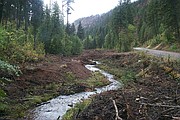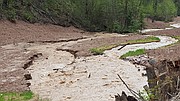Superfund cleanup making progress at Flat Creek
The once heavily contaminated Flat Creek is seeing great improvements as its Superfund cleanup nears completion, according to officials who visited the site earlier this spring.
Robert Wintergerst, a U.S. Forest Service engineer, monitored Flat Creek in June and reported that reclamation was holding up well.
The Iron Mountain Mine operated near Flat Creek, just north of Superior, from 1909 to 1930 and again from 1947 to 1953. The mine produced silver, gold, lead, copper and zinc ores, causing heavy metal contamination. The Environmental Protection Agency (EPA) found elevated levels of lead, arsenic, antimony, cadmium and manganese in 1993, which triggered a cleanup response.
The mine tailings were disposed next to the watershed which migrated into Flat Creek followed by the Clark Fork River. The EPA placed the site on the Superfund Program’s National Priorities List in 2009 and is nearing completion.
“We are seeing some improvements in the reclamation at the site from the previous year where we had substantial sedimentation reentering Flat Creek,” Wintergerst said.
Crews removed tailings in the upper Flat Creek, placed them in the Wood Gulch Repository, and reclaimed areas where the mine tailings had been removed, according to Steve Ackerlund, an environmental consultant who heads the Superior Technical Assistance Committee. The nonprofit committee formed to request grant money from the Environmental Protection Agency to clean up the mine tailings.
Wintergerst says they already removed most of the mine tailing deposits, but some additional deposits still remain. He’s currently developing removal designs which they hope to implement in the 2020 construction season. This would complete removal work.
The Department of Environmental Quality (DEQ) has also contributed to Flat Creek’s cleanup and have battled both weed removal and revegetation.
“A lot of vegetation had to be pulled out to access the mine tailings and the stream bank and bed had to be reinforced,” Ackerlund said.
Joel Chavez of the DEQ says 2019’s spring runoff did not cause as much damage as the previous year, but they are still recovering from the 2018 damage.
In 2018, spring runoff from the deep snowpack caused sedimentation to reenter Flat Creek and new vegetation and seeds washed away.
“I think it’s unfortunate the high water of 2018 got us, but I think we’re behind that now since we got through the water of 2019,” Chavez says.
“We’ve got vegetation well started and we’ll be in good shape.”
Chavez replanted trees this spring, reseeded the Flat Creek area, and sprayed knapweed. He says they will continue monitoring weeds annually.
“Any time you disturb the ground, you’re susceptible to more,” he said about the noxious weeds.
While most of the tailings have been removed in Flat Creek, there are still more tailing piles and portals further up the drainage which are dry and do not lie in creek beds, according to Ackerlund.
Mineral County submitted a grant this spring for the Superfund to clean up the dry tailings as a part of the Soils Displacement Program. Once the project receives funding and can clean up the remaining tailings, the Superfund project will be complete.
The local government and other individuals previously filled the tailings into Superior to use as fill materials on residential properties, the fairgrounds and the Superior High School track. Tailings from Superior were removed in 2002, 2010 and 2011 after the EPA discovered the contamination in 1993.
Ackerlund says there are still tailings beneath structures that they chose not to remove.
“The contamination was removed in areas where potential exposure exists,” he said. “It was left at depth and under structures that could create future exposure should there be construction work.”
He says they removed tailings two feet deep, but there are some remains beyond that.
As a part of the Soils Displacement Regulation, the EPA provides ongoing training to contractors and real estate agents.
“It’s a fancy word for a way to manage waste left in place,” Ackerlund said.
He says it’s subject to a five-year review program and under Superfund, the EPA has contractors come monitor the effectiveness of the programs every five years.
The EPA revisited and inspected the removal areas in Superior last fall and found that the remedy is “functioning as intended,” according to the EPA five-year review fact sheet. They did however find that “some property owner letters are not available or readily accessible from the database and some community members seemed unaware of the institutional controls.”
Property owner letters serve as official sampling records and documentation of the EPA’s findings. These letters were not readily available in the database, but Mineral County officials are working toward maintaining and finalizing the database to meet EPA standards.
“We noticed that not all real estate agents were aware how to access information in the database,” Ackerlund said.
The EPA is coordinating with the Mineral County Health Department to improve educational outreach and they plan to develop an institutional control implementation and assurance plan.
In the meantime, the U.S. Forest Service, the DEQ and the EPA are working to finish the Superfund cleanup by next year.





